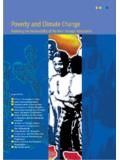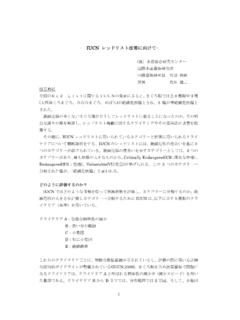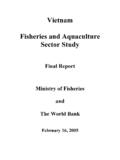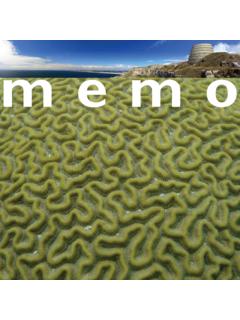Transcription of STATUS AND PROTECTION OF - WWF
1 STATUS AND PROTECTION OF GLOBALLY THREATENED SPECIES IN THE CAUCASUSCEPF Biodiversity Investments in the caucasus Hotspot 2004-2009 Edited by Nugzar Zazanashvili and David MallonTbilisi 2009 The contents of this book do not necessarily re ect the views or policies of CEPF, WWF, or their sponsoring organizations. Neither the CEPF, WWF nor any other entities thereof, assumes any legal liability or responsibility for the accuracy, completeness, or usefulness of any information, product or process disclosed in this book. Citation: Zazanashvili, N. and Mallon, D. (Editors) 2009. STATUS and PROTECTION of Globally Threatened Species in the caucasus . Tbilisi: CEPF, WWF. Contour Ltd., 232 978-9941-0-2203-6 Design and printing Contour , Kargareteli st.
2 , 0164 Tbilisi, GeorgiaDecember 2009 The Critical Ecosystem Partnership Fund (CEPF) is a joint initiative of l Agence Fran aise de D veloppement, Conservation International, the Global Environment Facility, the Government of Japan, the MacArthur Foundation and the World book shows the effort of the caucasus NGOs, experts, scienti c institutions and governmental agencies for conserving globally threatened species in the caucasus : CEPF investments in the region made it possible for the rst time to carry out simultaneous assessments of species populations at national and regional scales, setting up strategies and developing action plans for their survival, as well as implementation of some urgent conservation measures. 4 ContentsForewordAcknowledgmentsIntroduct ion CEPF Investment in the caucasus HotspotA.
3 W. Tordoff, N. Zazanashvili, M. Bitsadze, K. Manvelyan, E. Askerov, V. Krever, S. Kalem, B. Avcioglu, S. Galstyan and R. MnatsekanovThe caucasus HotspotN. ZazanashviliSpecies STATUS and Conservation StrategiesMammalsConservation of the Bezoar Goat in the Eastern caucasus Akhmedov, Yarovenko, Nasrullaev, Babaev and AkhmedovThe STATUS of Bezoar Goat (Capra aegagrus) in the Ka kar Mountains, TurkeyH. Diker, E. Diker, M. zalp, B. Avc o lu and S. KalemConservation Strategy for Armenian Mou on (Ovis [orientalis] gmelini Blyth) and Bezoar Goat (Capra aegagrus Erxleben) in ArmeniaI. G. Khorozyan, P. I. Weinberg and A. G. MalkhasyanConservation Strategy of the Asiatic Mou on (Ovis [orientalis] gmelini Blyth) and the Bezoar Goat (Capra aegagrus Erxleben) in AzerbaijanT. H. Talibov, P.
4 I. Weinberg, I. B. Mammadov, E. N. Mammadov and S. T. TalibovDaghestan Tur (Capra ylindricornis Blyth) Conservation Strategy in AzerbaijanS. M. Guliev, P. J. Weinberg and E. AskerovStatus of Turs in Georgia and Conservation Action PlanN. Kopaliani and Z. GurielidzeCurrent STATUS of Daghestan Tur (Capra cylindricornis) in the Eastern caucasus (Daghestan) D. Magomedov and Yu. A. YarovenkoGIS-based Habitat Modeling of Mountain Ungulate Species in the caucasus HotspotA. GavashelishviliTur of the caucasus : Morphology, Taxonomy and Conservation StrategyP. J. Weinberg, . I. iev and R. G. BuchukuriCurrent STATUS of the Eurasian Otter (Lutra lutra L.) in AzerbaijanN. I. Kasumova, E. Askerov, T. G. Aidinov, E. T. Mamedrzaeva and A. A. MamedovCurrent STATUS of Chiroptera Conservation in the CaucasusA.
5 Bukhnikashvili, S. Gazaryan, A. Kandaurov, I. Natradze, I. Rakhmatulina andE. Yavruyan789152632 37 465361 69748392985 Current STATUS of the Giant Blind Mole Rat (Spalax giganteus) in Omarov, Mahomedov and Yu. A. YarovenkoThe Current STATUS of Dahl s Jird (Meriones dahli Shidlovski, 1962) Sahakyan, G. M. Faivush and KalashianBirdsDevelopment of an IBA Caretaker Network in Priority CorridorsU. Gallo-Orsi, L. Balyan, M. Ghasabyan, . Isayev, E. Sultanov, Z. Javakhishvili and B. KurtSite Network for Birds and Wetlands: Inventory, PROTECTION and Community ManagementK. Lyubimova, S. Bukreev, T. Sviridova and G. DzhamirzoevReptiles and AmphibiansStudy of the Present STATUS of Amphibian and Reptile Populations for Updating the Red Data Book of Armenia and the IUCN Red Aghasyan, Aghasyan and KaloyanReassessment of the IUCN red list for Amphibians and Reptiles of the caucasus N.
6 B. Ananjeva, B. S. Tuniyev and N. L. OrlovStatus and Conservation of the Mediterranean Tortoise (Testudo graeca) in GeorgiaV. M. ChkhikvadzeDistribution and STATUS of Meditterranean Tortoise (Testudo graeca, Linnaeus, 1758) in Russia L. F. Mazanaeva, V. F. Orlova, E. V. Iljina and V. G. StarkovCurrent STATUS of the caucasus Toad (Bufo verucosissimus Pall., 1814) and caucasus Parsley Frog (Pelodytes caucasicus Boul., 1896) in Azerbaijan T. IskanderovStatus and Conservation of the Caucasian Salamander (Mertensiella caucasica)D. Tarkhnishvili and U. KayaConservation Strategy for Endemic Species of Caucasian Vipers (Pelias kaznakovi, P. dinniki)B. Tuniyev and S. TuniyevFishCurrent and Historical STATUS of Sturgeon (Acipenseridae, Osteichthyes) in GeorgiaA. GuchmanidzeTaxonomic STATUS of the Persian Sturgeon Acipenser persicus Borodin G.
7 I. Ruban, M. V. Kholodova, Kalmykov and SorokinInvertebratesArthropoda of the Hirkan Corridor and Hirkan National Park: red list UpdateKh. A. Aliyev, A. M. Atakishiyeva, S. A. Gadjiyeva, G. A. Huseynzade, E. F. Huseynov and T. G. MammadovaRare Invertebrates in Armenia M. Yu. Kalashian106111 117122 125 131137 143 151157165171178 1791836 PlantsDevelopment of Plant red list Assessments for the caucasus Biodiversity HotspotG. Schatz, T. Shulkina, G. Nakhutsrishvili, K. Batsatsashvili, K. Tamanyan, V. Ali-zade, D. Kikodze, D. Geltman and T. EkimRare and Endangered Plant Species in Hirkan National Park and its EnvironsH. M. SafarovSpecies Diversity and Conservation Priorities for Endemic Plants of Georgian-Turkish Transboundary Zone in the West Lesser caucasus CorridorZ. Manvelidze.
8 Emina ao lu, N. Memiadze and D. KharazishviliArea ProtectionEnhancing Conservation in the West Lesser caucasus through Transboundary Cooperation and Establishing a Training Program on KBA ConservationE. Caglayan, Y. Lise and A. GavashelishviliDemographic, Geo-ecological and Socioeconomic Characteristics of the West Lesser caucasus for New Protected Areas Planning N. Elizbarashvili, D. Nikolaishvili, G. Meladze, G. Beruchashvili and D. LipartelianiInventory of Internationally and Nationally Important Wetlands in the Russian caucasus RegionI. KamennovaTerritorial PROTECTION of Globally Threatened Species in the CaucasusN. Zazanashvili, K. Manvelyan, E. Askerov, V. Krever, S. Kalem, B. Avcioglu, S. Galstyan, R. Mnatsekanov and M. Bitsadze 188193 199 206 211 220 222 7 ForewordThe caucasus is among the top 34 biologically richest and most endangered biodiversity hotspots in the world.
9 Two of these hotspots are found in Europe, the Mediterranean and the caucasus . Illegal logging, uncontrolled hunting, oil and gas developments, agriculture and overgrazing contribute to an ever increasing degradation of the spectacular and fragile mountainous regions of the caucasus , with effects on wildlife and people. Only 12% of the region s natural ecosystems are in their original collapse of the Soviet Union led to dramatic changes in the region. Newly-independent countries became a focus of international attention; conservation of the natural and cultural heritage became a high priority. The rst major initiative came from WWF in 1990. Support was provided to identify a system of protected areas in Georgia. This led to the establishment of WWF s rst of ce in the caucasus which soon expanded its activities to neighboring countries and initiated the Analysis of Biodiversity and Current Threats of the caucasus Ecoregion and the elaboration of an Ecoregion Conservation Plan (ECP) for the entire caucasus .
10 More than 150 scientists and conservationists were involved from all six countries. Both studies became major instruments for raising support for conservation from the international donor community. The most important contributor to the implementation of the ECP was the Critical Ecosystem Partnership Fund (CEPF). This support came at a critical time with funding for projects to strengthen civil society and the NGO network, maintain and upgrade important wildlife corridors, improve the STATUS of globally threatened species and important landscapes and natural sites. All these activities contribute to the creation of an effective ecological network of protected areas which is the basis for improving PROTECTION and management of the region s biological resources.







